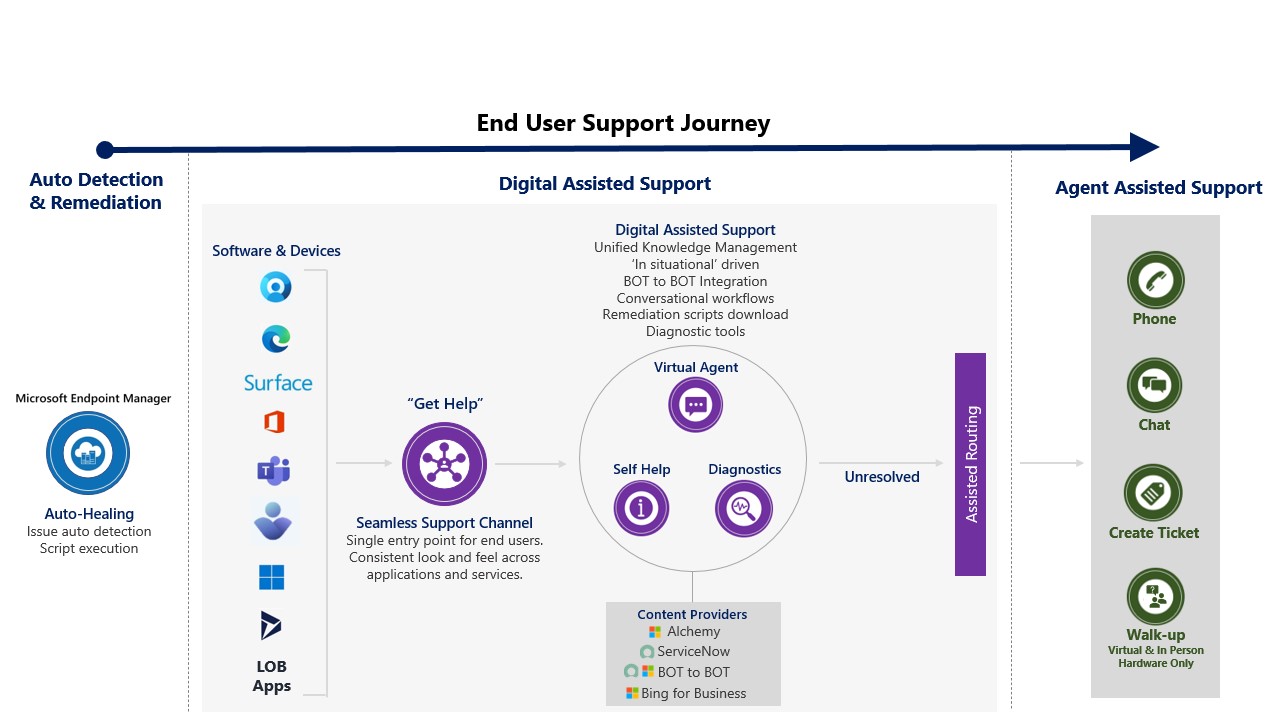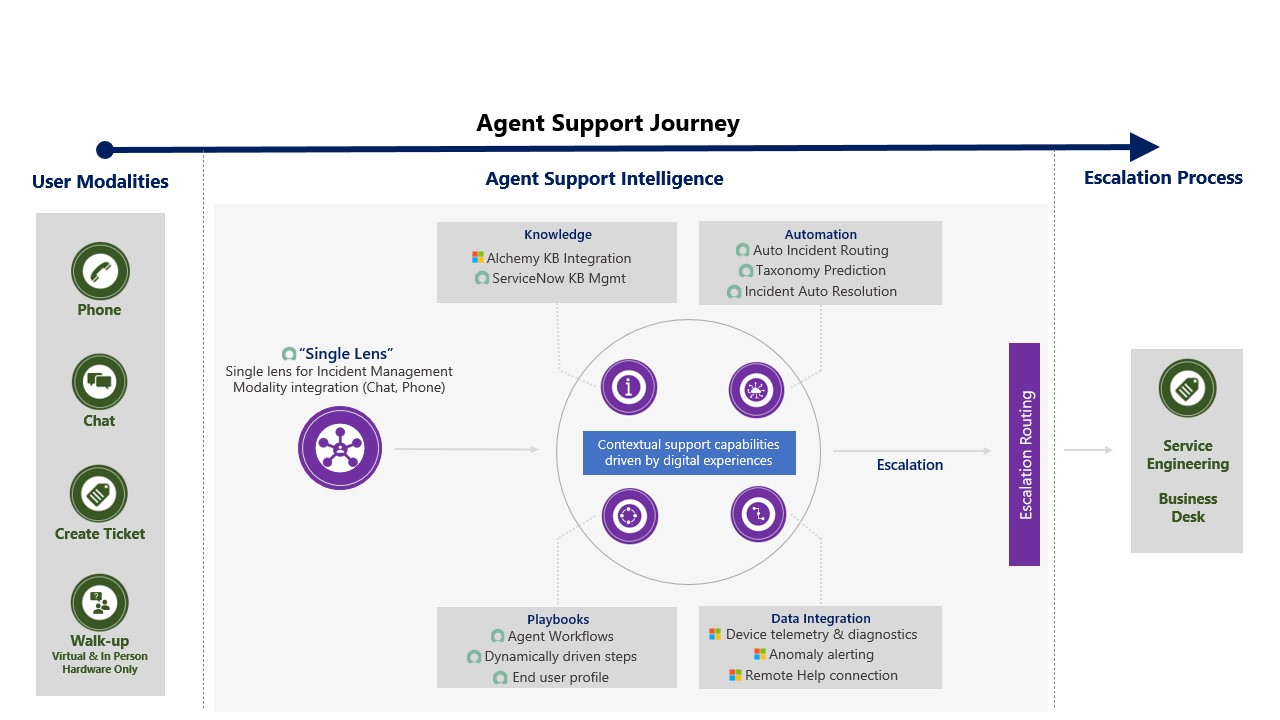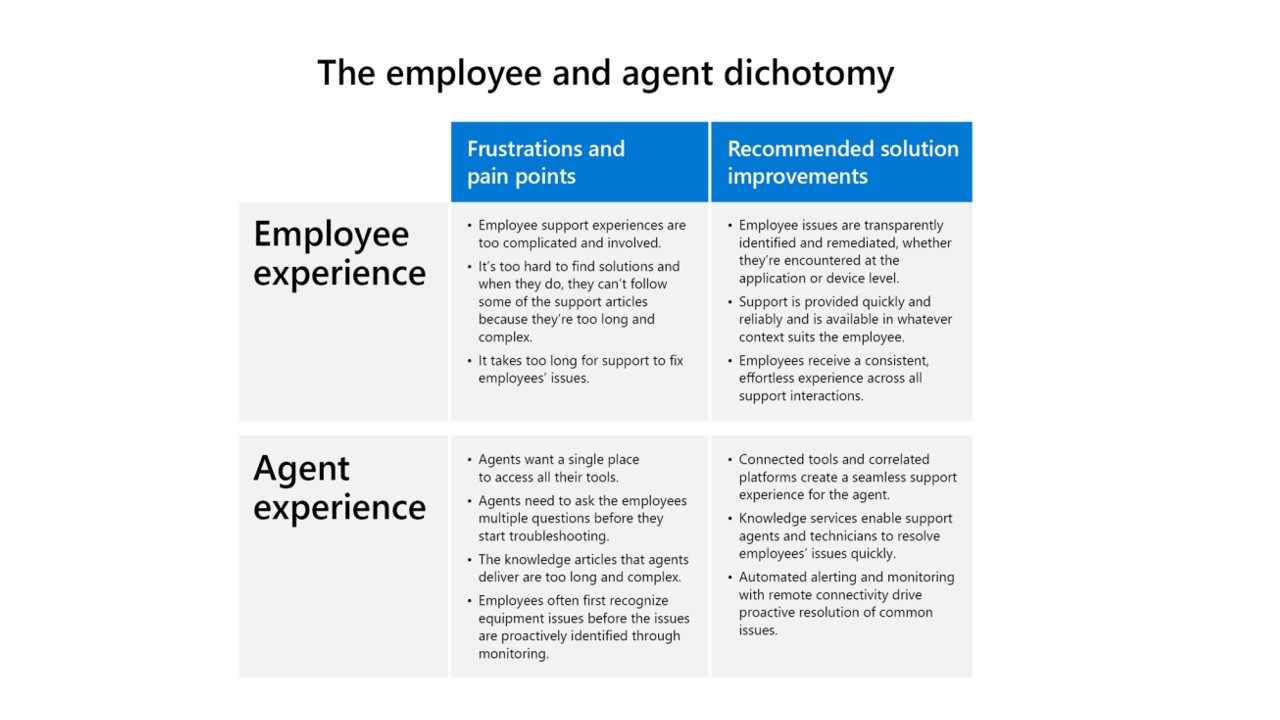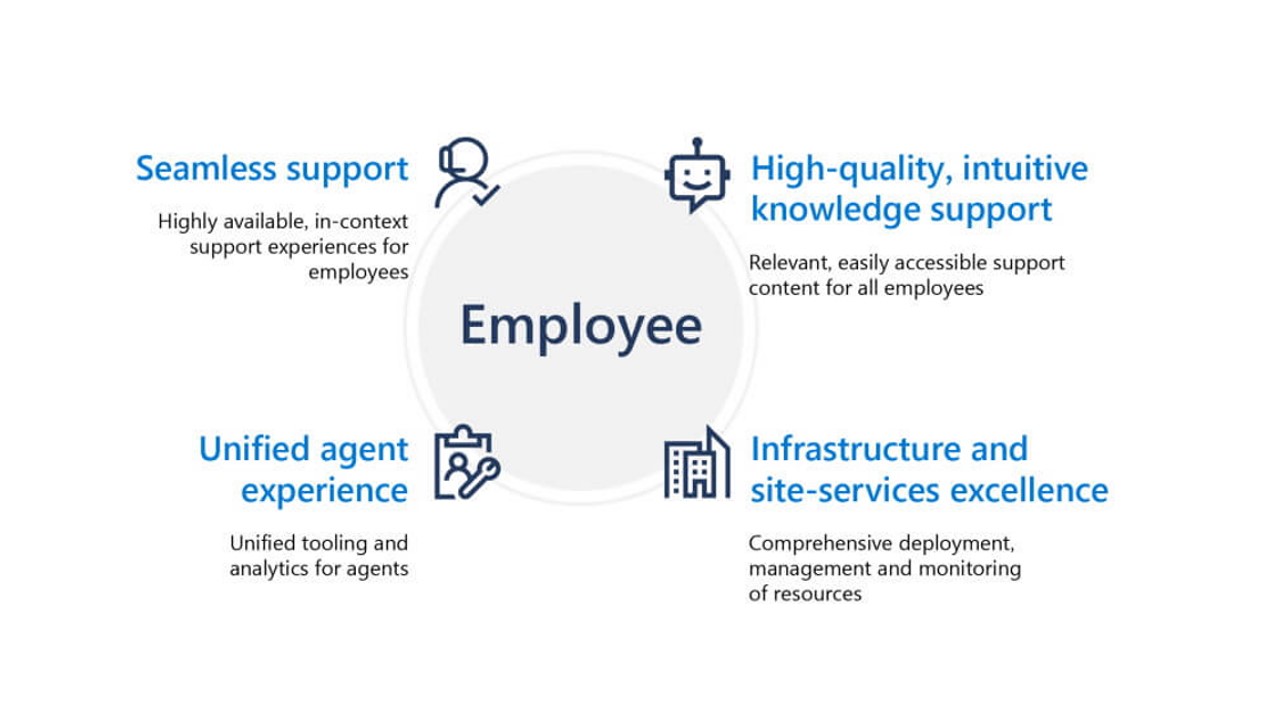 To maximize the value of digital transformation in a complex, global organization like Microsoft, a new modern approach to employee support is required. That is why Microsoft Digital, the company’s IT organization, is reimagining how to deliver support experiences to the company’s employees across physical and digital interactions. This has never been more critical as employees across the globe are adapting to a hybrid work environment.
To maximize the value of digital transformation in a complex, global organization like Microsoft, a new modern approach to employee support is required. That is why Microsoft Digital, the company’s IT organization, is reimagining how to deliver support experiences to the company’s employees across physical and digital interactions. This has never been more critical as employees across the globe are adapting to a hybrid work environment.
Microsoft Digital is creating a modern support experience that focuses on identifying and remediating issues automatically by enabling seamless support, generating high-quality knowledge content, providing a unified agent experience, and maintaining infrastructure and site-service excellence.
“In talking with our customers and partners, we are hearing that a modern digital support experience that can enable a hybrid working environment is a priority but may seem daunting and complex,” says Trent Berghofer, General Manager of Microsoft’s Modern Support team in Microsoft Digital. ”However, with a comprehensive vision-led approach and targeted investment, the results yielded can have a significant impact.”
Modern Support is part of a broader vision focused on enabling the most productive employee experience possible in today’s ever-changing environment. The team is a diverse, multi-disciplined group of IT professionals that manage end user support, site services, infrastructure deployments, and venture integration to drive employee productivity. This team plans, learns, and adapts to drive and transform the modern employee support journey at Microsoft.
To create an efficient and effective digital first employee support experience, the Modern Support team is improving auto-healing capabilities and enabling digitally assisted support through seamless interaction for employees by providing broad access to support with in-context tools.

Transforming agent assisted support at Microsoft
Although service-level metrics have traditionally been important in overall support health, the need to put greater emphasis on the digital employee experience has proven to be critical. It’s important to understand not only if services and tools are functioning properly, but also whether they meet employees’ and support agents’ needs.
In the area of agent assisted support, Modern Support efforts focus on the two key roles that participate in support activities: employees who experience and report issues and the support agents and technicians who track and resolve those issues.

Several factors prevent employees and agents from experiencing and delivering optimal support. The shift from a support model where work tasks are costly, complex, and require significant support intervention to a model that creates experiences that are easily discoverable, simple, accessible, personalized, and automated greatly improves the overall dynamic. By connecting the experiences that exist today—and the ones in the future—in an end-to-end way, this new model better reflects how people want to seek help, outlined below.

The four pillars of Microsoft’s Modern Support Experience
The team is pursuing Microsoft’s Modern Support vision based on these four critical pillars with our employees in the center.

Pillar 1: Seamless support
Employees need to have the most simplified and transparent support experience possible. For example, if an employee reports an issue with an app they are using, relevant telemetry needs to be gathered systematically and, if possible, trigger automated workflow tasks to help resolve the problem immediately. By using telemetry from the employee’s device, information about the current application context and other relevant data, the system supplies automated remediation tasks to resolve the issue without agent intervention. If automated remediation isn’t possible, users can engage the Virtual Agent from within the app to help diagnose and resolve the issue and, if unsuccessful, the user can be seamlessly handed off to the most appropriately skilled agent via phone or chat with all the previous steps and telemetry provided on a ticket automatically.
As employees embraced hybrid work, Modern Support reopened walk-in support centers by appointment only and added or transformed some locations to virtual support kiosks with video support capability. These centers, both physical and virtual, use technology for online booking and focus on hardware-related issues to minimize wait time while enabling a seamless environment. Employees are able to book an appointment via the Virtual Agent so the bot can drive self-help solutions before finalizing an appointment. Modern Support remains committed to delivering an experience that anticipates the different ways employees need assistance while providing the flexibility and agility employees now require. The team works diligently to resolve the issue remotely prior to having an employee physically show up to a walk-in center.
Also, a 24-hour exclusive executive support service was designed to quickly resolve technology-related issues for our company’s leadership team and their executive assistants. Executive support services also focus on and identify automation opportunities that can be applied throughout the organization.
Key results
Seamless support investments have produced three key results:
- Employees have more time to focus on their job because issues are automatically identified and remediated transparently on their devices. This means less interaction and time interfacing with support.
- Employees get support anytime, anywhere, and the efficient ticketing process doesn’t require a repetitive description of issues or tedious tasks.
- There has been an increased ratio of successful unassisted support incidents vs. assisted support––from 15 percent to 40 percent.
Pillar 2: High-quality, intuitive knowledge support
At Microsoft, employees are empowered to seek self-remediation methods. Accordingly, investments in the capabilities of the company’s knowledge systems make them easier to use for both employees and support agents. Multiple self-help and virtual-agent modalities driven by powerful search technologies that automatically present to employees accurate, meaningful, and simple-to-follow content help them mitigate issues quickly.
Modern Support is rethinking the company’s knowledge base to improve the experience and increase efficiency for employees and support agents. It includes expanding the scope of knowledge for our self-help tools and Virtual Agent, and driving a set of standards, quality, and best practices for the lifecycle management of knowledge content. Integrating with Microsoft 365 Knowledge Base provides not only issue-tracking capability but also automated support processes and predictive recommendations.
Through a broad partnership across multiple teams, employees can retrieve content from a single-entry point that searches multiple domains transparently, including Bing for Business, Microsoft SharePoint, Microsoft 365 Alchemy, and the traditional support portal. GS&VI resources include a broader range of media types to provide a more optimal support experience. Short, easily consumable, on-demand guidance videos also better support individual content-consumption preferences.
New employee onboarding processes are being improved to ensure employees are prepared for new products and services introduced into their workflow. This also includes new employee onboarding for companies that have been acquired by Microsoft. A complete toolset leveraging Microsoft Viva is now available to new employees to enable them to be more productive on their first day of employment. This is accomplished by unifying onboarding approaches, creating a consolidated content platform, and introducing learning paths based on employee roles and business functions.
Key results
Intuitive knowledge support efforts have produced these key benefits:
- Support content is accessible, simple, easy to follow, and targets a broad reading level and regional context.
- Consumption of support content is tracked and can be correlated to a reduction in employee-initiated support inquiries.
- New employees can more easily find and use knowledge content their first day on the job.
- Employees can easily find and subscribe to high-quality training content that’s relative to the tools and services they use in a variety of media types.
Pillar 3: Unified agent experience
Our support agents and technicians also need the proper toolset to fix issues quickly and support Microsoft employees. To meet this goal, the team is developing and using connected tools and correlated platforms that increase information reuse and employ data pertaining to the support environment. The result will be a seamless experience for both agents and employees.
To improve the agents’ experience, toolsets are being made more intelligent by using machine learning and predictive analytics to enable our agents to access all the information they need to resolve an issue. Telemetry captured on the ticket will drive recommendations and workflows for the agent so they can supply the quickest resolution possible. Intelligent playbooks have also been implemented that automatically present themselves to the agent. These playbooks, based on issue classification, help guide the agent through the troubleshooting process with the employee and ensure a consistent, efficient experience.
Predictive Intelligence allows us to automate many mundane tasks agents must do, such as issue triage and taxonomy management. Tickets are routed to the right team for the first-time using machine learning capabilities, avoiding the need for an agent to review and transfer the task to someone else. This eliminates the waste of time on the ticket lifecycle, thus providing a faster solution for the user. Using Predictive Intelligence, we are also prepopulating taxonomy on behalf of the agent so they can focus on issue resolution and not issue classification.
For tickets created from email or the web and not via our self-help solutions, we are now handing off the management of these tickets to the virtual agent. If a solution is within the scope of the Virtual Agent, then they will proactively reach out to the employees in Microsoft Teams to help on their issue. If successful, the Virtual Agent will manage the update and closure of the ticket. This enables our agents to focus on the most complex problems.
The ticket-resolution toolset gathers robust employee sentiment from chat experiences, call-quality data, and Yammer communities. This information helps agents understand the issues’ complete context and respond more appropriately to the initial employee contact. Agents need to enter the issue-resolution process with the greatest possible chance of success. Employee sentiment also helps Microsoft’s leadership and key stakeholders better understand the issue-resolution process and where intervention might be warranted. The data also helps our product groups and partners to continually improve.
Key results
Unified agent efforts have produced these key benefits:
- A single lens and data repository for the agents. They can manage and interact with tickets from a single location.
- Proactive and predictive support insights. Agents can find and potentially resolve issues before they’re reported by employees.
- Enhanced automated-support capabilities. Automation-assisted mitigation actions expedite resolution of technical issues.
- Automated ticket management and resolution via the Virtual Agent for simple issues.
Pillar 4: Infrastructure and site-services excellence
Aligned with our vision for hybrid workplaces, which enable our people to be connected, engaged, and productive wherever they are, Modern Support field-based teams drive the deployment and operation of innovative technologies and services for over 790 buildings in 110 countries. Modern Support teams are digitalizing on-site experiences and enabling physical spaces as a strategic tool to reenergize our workforce, maintain engagement, and attract and retain the best talent.
Hybrid work is driving significant realignment of how we utilize our physical spaces worldwide, impacting key infrastructure related to collaboration, connectivity, and security. In response to this demand, our infrastructure and AV deployment teams have implemented robust global technology standards to maximize value and drive consistent experiences for our global user base. Unifying data sets such as building occupancy and incident volume with historic project delivery data (including cost, scheduling, and deviations) yields critical insights to support ongoing investment prioritization. Combined with data collected during each project delivery phase (deployment, provisioning timelines, and associated costs), we are able to drive reductions in total cost of ownership and increased overall return on investment through enhanced planning and delivery processes.
One consequence of the shift to hybrid work has been increased demand for richer meeting room experiences that better accommodate remote and in-person participants. To support this demand, Modern Support teams are deploying new Microsoft Teams-powered hybrid meeting room technology across our 14,000 AV-enabled conference rooms worldwide. Bringing remote attendees “into the room” is moving us closer to parity of experience for those attending outside the office.
Key to enabling our vision of digitalizing on-site experiences and empowering our field-based teams is a focus on unifying existing data sources to allow critical insights around workplace experience health. Using infrastructure telemetry (such as network, AV, and environmental (IoT)) to corroborate employee sentiment, captured through both surveys and dynamic sentiment analysis, enables a holistic view of employee experiences in our physical spaces. This data-driven approach has allowed us to introduce the concept of a franchise model to empower Field IT Managers to be fully accountable for services delivered within their geographic scope and effectively drive experience improvement activities.
As we look to embrace the opportunities presented by automation and AI, we are deploying services such as “Just in Time” (JIT) cable room access alongside AI-driven “Computer Vision” solutions to monitor the critical infrastructure hosted in over 1,200 cable rooms globally. Doing this enables us to automate change management processes and ensure physical security for crucial infrastructure components at our sites across the globe. Enriching our CMDB (Configuration Management Data Base) capabilities with these and other new data sources has been key to automating Device Lifecycle Management (DLM) processes across our estate.
Through our continued focus on digitalizing the delivery of our critical on-site experiences, we can optimize support costs while driving employee satisfaction and productivity, aligning with our mission to transform the employee support journey at Microsoft.
Key results
Infrastructure and site-services efforts have produced these key benefits:
- All infrastructure projects are delivered on time, on budget, and within standards or with approved deviations.
- Alert monitoring is on all meeting room assets and site infrastructure (network, IoT) to increase proactive issue detection.
- Customer satisfaction metrics for Modern Support services are met or exceeded at the geographic and site level.
Modern support experience benefits
The Modern Support experience at Microsoft is transforming the way employees and agents experience and provide support across the company. This environment enables employees to be creative, innovative, and productive by providing a support experience that focuses on identifying and remediating issues automatically—before employees are even aware they exist. By creating a seamless support experience, creating high-quality knowledge content, supplying a unified agent experience, and maintaining infrastructure and site-services excellence, employees’ support interactions are greatly improving. This Modern Support experience gives everyone at Microsoft broad, inclusive access that enables employees to do more with less and empowers every person and every organization to achieve more.

Here are tips you can try as you work to transform your support experience at your company:
- Take a vision-led and phased approach when modernizing your support experience.
- Place greater emphasis on the employee experience when measuring your service level support metrics.
- Increase employee productivity by detecting and remediating issues proactively before your employees report them.
- Invest in seamless, in-context support and simple, intuitive knowledge systems to improve employee experience and efficiency.
- Establish a listening system across the organization that can engage with your local stakeholders and employees and be accountable for support services and experience.





